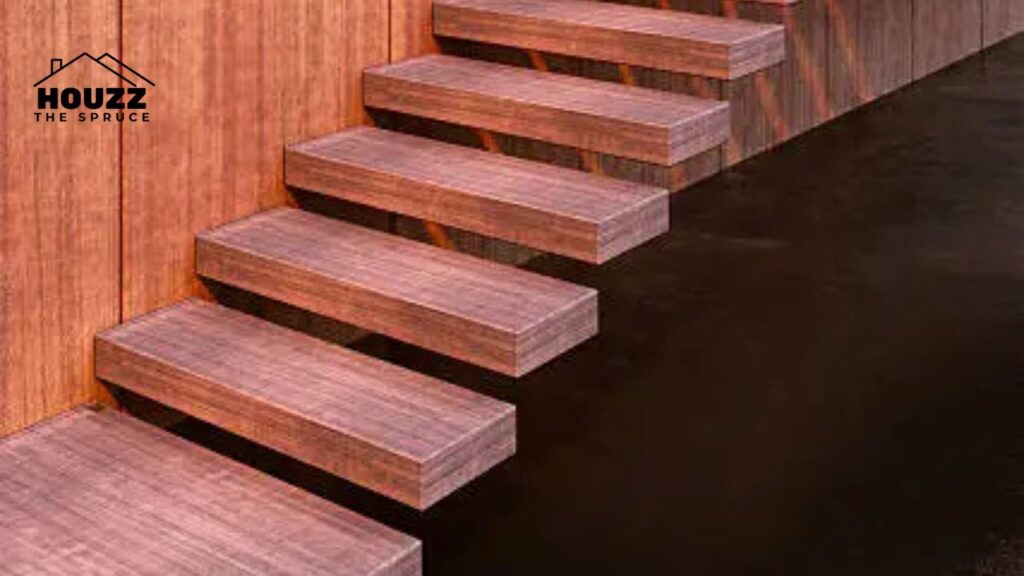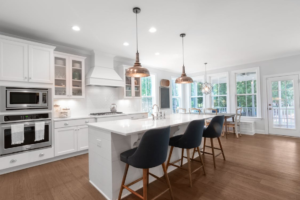Have you ever walked into a home or office and noticed a staircase that looked like it was floating in mid-air? No bulky supports. No heavy frames. Just sleek, modern steps that seem to hover gracefully. That magical design you admired most likely involved a floating stairs stringer—the hidden (or sometimes beautifully exposed) backbone that makes floating stairs possible.
If you’ve been searching for stylish, space-saving, and modern staircase ideas, you’ve landed in the right place. In this section, we’ll uncover what makes floating stairs stringer systems so special, how different types like mono stringer floating stairs, double stringer floating stairs, or closed stringer floating stairs work, and why they’ve become the go-to choice for homeowners, architects, and interior designers who want both function and beauty.
Let’s dive in, step by step.
What Exactly Is a Floating Stairs Stringer?
At its core, a stringer for floating stairs is the structural beam or support that holds the staircase together. In traditional staircases, you often see two bulky stringers on either side. But in floating stairs, the design is clever: the support is either minimized, hidden, or designed in such a way that the stairs look like they’re levitating.
The floating stairs stringer can be:
- Single (Mono) Stringer – one central beam holding everything together.
- Double Stringer – two slim beams on either side for added strength and balance.
- Closed Stringer – where the stringer is hidden, making each tread look seamless.
This is where the magic happens. Without the stringer, the stairs would just be wooden planks, metal frames, or glass panels with nowhere to sit.
Why Floating Stairs Capture Hearts and Attention
Think about this: a staircase isn’t just for climbing. It’s a centerpiece in your home. And nothing draws the eye quite like a sleek floating stairs with metal stringer or a mono stringer floating stairs design.
Here’s why people fall in love with them:
- Modern Aesthetics – Floating stairs scream elegance and simplicity. They match perfectly with minimal, industrial, or even luxury interiors.
- Space-Saving Design – The open layout creates the illusion of more room, which is a lifesaver in smaller houses or apartments.
- Customization Options – From fancy neoclassic floating stairs no stringer for those who love dramatic styles, to diy floating stairs single stringer for the adventurous home builder, the options are endless.
- Durability & Strength – Despite looking light, the stringer for floating stairs is engineered to be strong, often made of steel, iron, or reinforced wood.
Exploring the Types of Floating Stairs Stringers
Let’s break down the most popular types, because this is where many homeowners get confused. Should you choose single stringer floating stairs? Or go with double stringer floating stairs? Maybe a sleek closed stringer floating stairs? Each has its own charm.
1. Single Stringer Floating Stairs
Also called mono stringer floating stairs, this type uses one central support beam underneath the steps. It creates a clean, minimal look where the steps seem to hover.
- Best for: modern homes, open-concept spaces.
- Bonus: can be customized with different mono stringer floating stairs material, like steel for industrial vibes or wood for a warmer feel.
2. Double Stringer Floating Stairs
Here, you have two beams—usually slimmer than traditional ones—on each side of the stairs.
- Best for: spaces that need extra strength and stability.
- Visual effect: balanced, symmetrical, and still modern without feeling too industrial.
3. Closed Stringer Floating Stairs
The stringer is hidden from view, making each step look seamless.
- Best for: luxury interiors, minimalists who love clean lines.
- Often used with glass railings for that “wow” factor.
4. Fancy Neoclassic Floating Stairs No Stringer
This design skips the visible stringer entirely, relying on wall mounts or hidden engineering. It’s not really “no stringer,” but it appears that way.
- Best for: high-end, dramatic interiors.
- A true showstopper if you want guests to remember your staircase forever.
5. DIY Floating Stairs Single Stringer
For the DIY enthusiast, building your own diy floating stairs single stringer can be a fun project. It requires careful planning, strong materials, and a keen eye for safety.
- Best for: handy homeowners, smaller projects.
- Warning: not for beginners—structural mistakes can be dangerous.
Materials Matter: Choosing the Right Stringer
When we talk about a floating stairs with metal stringer, it’s not just about looks—it’s also about strength. The mono stringer floating stairs material plays a huge role in durability.
Common choices include:
- Steel – Strong, sleek, industrial. Perfect for modern lofts.
- Wood – Warm, classic, but needs reinforcement for safety.
- Glass or Acrylic – Rare, but stunning. Mostly decorative with hidden metal stringers.
Mixing materials is common, too. For instance, wood treads on a steel left side single stringer floating stairs design create a perfect balance between warmth and modernity.
Why Placement Matters: Left Side vs. Center Stringers
Placement is another detail people don’t often consider. The left side single stringer floating stairs is a creative choice when you want one side open and airy while the other hugs the wall. This makes it safer but still gives that floating illusion.
Meanwhile, central mono stringer floating stairs are perfect when you want the staircase to be the star of the room.
Emotional Connection: More Than Just Stairs
At the end of the day, floating stairs aren’t just about function. They’re about feeling. A floating stairs stringer design makes your home look like something out of a magazine. It gives you pride when guests gasp, “Wow, your stairs look amazing!”
And if you’ve ever dreamed of a modern, stylish home, installing floating stairs with metal stringer or single stringer floating stairs might be the easiest way to bring that dream to life.
Quick Recap Before We Climb Higher
So far, we’ve discovered:
- What a stringer for floating stairs is and why it matters.
- The different types: single, double, closed, and even fancy no stringer designs.
- Material choices that balance beauty and strength.
- Why placement (like left side single stringer floating stairs) changes the feel of a room.
This is just the beginning. Floating stairs are not only about looks—they’re about durability, safety, and design harmony with your space. In the next section, we’ll go deeper into choosing the right style for your home and weighing the pros and cons of each type.
But for now, imagine yourself walking up a mono stringer floating stairs that seems to hover in your living room. Imagine the light streaming through the steps, the space looking bigger, and your home transformed into something spectacular.
That’s the magic of a floating stairs stringer.

Popular Styles of Floating Stairs Stringer (With FAQs & Design Tips)
If Section 1 introduced you to the basics of a floating stairs stringer, this section will help you explore the most popular styles in detail—plus, we’ll sprinkle in design tips and answer common questions that homeowners often ask before choosing their staircase style.
1. Mono Stringer Floating Stairs
The mono stringer floating stairs—also called single stringer floating stairs—use just one central beam. This makes them sleek, modern, and highly versatile.
✨ Design Tips
- Pair mono stringer floating stairs material like steel with wood steps for a warm yet modern feel.
- Add glass railings to boost the floating effect.
- Use LED step lighting for a futuristic look at night.
2. Double Stringer Floating Stairs
The double stringer floating stairs add extra strength with two slim beams.
✨ Design Tips
- Use metal stringers with wooden treads for balance between strength and beauty.
- If you want a wider staircase, this style offers stability without losing elegance.
- Powder-coat the stringers in black or white to match your décor theme.
3. Closed Stringer Floating Stairs
A closed stringer floating stairs design hides the stringer completely, leaving you with seamless floating steps.
✨ Design Tips
- Combine with frameless glass railings for maximum luxury.
- Best suited for minimalist homes—avoid clutter around it to let the design shine.
- Try light-colored steps if your walls are dark, for dramatic contrast.
4. Fancy Neoclassic Floating Stairs No Stringer
This bold design—fancy neoclassic floating stairs no stringer—looks magical and dramatic.
Design Tips
- Works beautifully in tall, open spaces like villas or duplex homes.
- Combine marble or stone steps with hidden supports for a royal look.
- Consider dramatic chandeliers or lighting above the stairs to highlight the illusion.
5. DIY Floating Stairs Single Stringer
Some homeowners try their hand at diy floating stairs single stringer projects.
Design Tips
- Always research local building codes before starting.
- Use steel as your stringer for floating stairs if you want lasting strength.
- Test the staircase thoroughly before use—safety always comes first.
6. Floating Stairs with Metal Stringer
The floating stairs with metal stringer is a durable, modern favorite.
Design Tips
- Perfect for industrial-style homes with exposed brick or concrete.
- Add wooden steps to soften the industrial look.
- If you prefer a bold style, paint the stringer a bright accent color.
7. Left Side Single Stringer Floating Stairs
The left side single stringer floating stairs offer a creative placement option.
Design Tips
- Great for hallways where one side is against a wall.
- Use slim railings or keep the open side free for maximum effect.
- Consider neutral steps with a bold stringer color for contrast.
FAQs About Floating Stairs Stringer
Q1: Are floating stairs safe?
Absolutely! A properly built floating stairs stringer is engineered to hold significant weight. Styles like double stringer floating stairs or floating stairs with metal stringer are especially strong.
Q2: Can I install floating stairs myself?
If you’re skilled, you can try a diy floating stairs single stringer project. However, because safety is critical, most people hire professionals.
Q3: Which material is best for a stringer?
Steel is the most reliable mono stringer floating stairs material because it provides both strength and longevity. Wood can work, but it often needs reinforcement.
Q4: How much do floating stairs cost?
Costs vary by style and material. Fancy neoclassic floating stairs no stringer are usually more expensive due to hidden engineering, while mono stringer floating stairs are more budget-friendly.
Q5: Can floating stairs work in small homes?
Yes! In fact, designs like single stringer floating stairs or left side single stringer floating stairs are great for small spaces since they make the area feel open and airy.
Q6: Do floating stairs need railings?
Not always, but railings are recommended for safety. Glass railings are popular because they keep the floating illusion intact.
Q7: What is the difference between single and double stringers?
A single stringer floating stairs uses one central beam, while double stringer floating stairs use two slimmer beams. Single looks more minimal, while double offers more support.
Wrapping Up with a Design Perspective
When it comes to picking your style of floating stairs stringer, it all comes down to personality and lifestyle.
- Want bold elegance? Choose fancy neoclassic floating stairs no stringer.
- Prefer minimalism? Go for mono stringer floating stairs.
- Need strength for kids or heavy use? Double stringer floating stairs or floating stairs with metal stringer are great picks.
- Love unique designs? The left side single stringer floating stairs gives you a creative edge.
- Handy and adventurous? Try a diy floating stairs single stringer project (but only if you’re skilled!).
At the end of the day, your staircase isn’t just about moving between floors—it’s a design statement that reflects your taste and lifestyle.
Admin Recommendation
Blue Kitchen Cabinets: Stylish Ideas, Colors & Designs for Every Home












